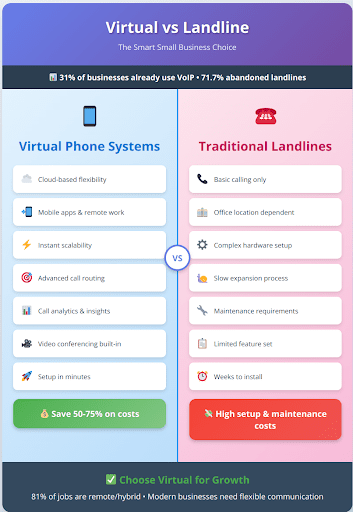Virtual phone numbers deliver superior value for most small businesses compared to traditional landlines.
- Cost savings of 50-75% on communication expenses compared to traditional systems • Advanced features like video calling, mobile apps, and automated attendants included • Complete mobility allowing work from anywhere with internet connection
• Instant scalability to add users and numbers without hardware installation
Recommendation: Unless your business operates exclusively from a single location with minimal growth plans, virtual phone systems offer better ROI and future-proofing for small businesses.
Small businesses today face a critical communication decision that can impact both their budget and growth potential. While 71.7% of US adults have abandoned landlines in favor of wireless and internet-based alternatives, many business owners still wrestle with choosing between virtual phone numbers and traditional landline systems.
The communication landscape has shifted dramatically, with 31% of businesses now utilizing VoIP solutions and that number growing rapidly each year. This transformation reflects broader workplace changes, as 81% of remote-capable jobs are now either exclusively remote or hybrid, demanding more flexible communication solutions.
Understanding the differences between these small business phone options can mean the difference between a communication system that constrains your growth and one that accelerates it. With 33.2 million small businesses representing 99.9% of all US businesses, making the right phone system choice has never been more crucial.
What Are Virtual Phone Numbers?
Virtual phone numbers represent a modern approach to business communication that breaks free from the physical limitations of traditional telephony. Unlike landlines that require copper wires and fixed hardware, virtual numbers operate through Voice over Internet Protocol (VoIP) technology, using your existing internet connection to handle calls.
These cloud-based systems function by converting your voice into digital data packets that travel over the internet to reach their destination. The process happens so quickly that conversations feel completely natural, often with better call quality than traditional phone lines.
The key advantage lies in their flexibility. A virtual phone number isn’t tied to a specific device or location—it can ring on your desk phone, mobile device, computer, or all three simultaneously. This means you can answer business calls whether you’re in the office, working from home, or traveling across the country.
Virtual systems also integrate seamlessly with modern business tools. Features like video meetings, team messaging, call analytics, and CRM integration come standard with most platforms, creating a unified communication hub rather than just a phone line.
How Traditional Landlines Work
Traditional landline systems operate on technology that’s remained essentially unchanged for over a century. They rely on copper wires and physical infrastructure to carry analog voice signals through the Public Switched Telephone Network (PSTN).
When you make a call on a landline, your voice converts into electrical signals that travel through copper wires to your phone company’s central office, where they’re routed to the recipient. This process requires extensive physical infrastructure, from the cables running to your building to the switching equipment at telephone company facilities.
For businesses, landline systems typically involve on-premises Private Branch Exchange (PBX) equipment—bulky hardware that manages call routing, voicemail, and basic features. Each phone line requires a separate physical connection, and adding new lines means installing additional hardware and potentially rewiring your office.
While this traditional approach offers proven reliability, it also creates significant limitations. Every phone is tethered to a specific location, employees can’t take their business number with them, and system changes require technician visits and hardware modifications.
Virtual Phone Number vs Landline: The Complete Comparison
Cost Structure and Savings
The financial differences between virtual and landline systems extend far beyond monthly service fees. Research indicates that businesses switching to VoIP can see average savings of 50% to 75% compared to traditional landline systems.
Traditional landline costs include installation fees (often $100-300 per line), monthly service charges ($25-70 per line), equipment purchases or leases, maintenance contracts, and significant long-distance charges. Adding new lines requires additional hardware and installation costs, making expansion expensive and time-consuming.
Virtual phone systems typically operate on predictable monthly subscriptions, usually ranging from $15-40 per user depending on features included. Most providers eliminate setup fees entirely, require no special hardware purchases, and include long-distance calling within their base pricing. International calling rates through virtual systems can be up to 90% less expensive than traditional landline charges.
The total cost of ownership heavily favors virtual systems, especially as businesses grow and need additional lines or features.
Feature Capabilities and Business Tools
Traditional landlines offer basic calling features like voicemail, caller ID, and call waiting. More advanced features require expensive add-ons or sophisticated on-premises equipment that demands professional installation and maintenance.
Virtual phone systems include dozens of advanced features as standard offerings. These typically encompass auto-attendants that professionally greet callers, call routing that ensures customers reach the right person, voicemail-to-email transcription, call recording for training purposes, and detailed analytics showing call patterns and performance metrics.
Modern virtual systems also integrate communication channels beyond voice calls. Video conferencing, team messaging, file sharing, and mobile applications create a comprehensive business communication platform rather than just a phone service.
Many virtual providers also offer AI-powered features like intelligent call routing, automated appointment scheduling, and spam call filtering—capabilities that would be impossible or prohibitively expensive with traditional landline infrastructure.
Mobility and Remote Work Support
The mobility comparison reveals perhaps the starkest difference between these systems. Landlines anchor employees to specific physical locations, limiting flexibility and remote work capabilities.
Virtual phone systems excel in supporting distributed teams and remote work arrangements. Employees can access their business phone number from anywhere with internet connectivity, using smartphones, laptops, or tablets. This flexibility proved crucial during recent workplace changes, allowing businesses to maintain professional communication regardless of employee location.
Call forwarding with virtual systems is seamless and instant, automatically routing calls to mobile devices, home offices, or other locations without caller awareness. Traditional landlines require manual call forwarding setup and often result in poor call quality or additional charges.
Reliability and Call Quality
Traditional landlines built their reputation on reliability, particularly during power outages when the phone network could operate independently of local electrical systems. However, modern infrastructure increasingly relies on digital components that can fail during emergencies.
Today’s virtual phone systems offer excellent reliability through redundant data centers, automatic failover systems, and multiple internet pathways. Quality virtual providers maintain high uptime standards and offer superior call quality through high-definition voice technology.
The reliability question often depends more on internet connectivity quality than the phone system itself. Businesses with robust internet connections typically experience better performance with virtual systems than traditional landlines.
Scalability for Growing Businesses
Scaling traditional landline systems requires significant planning, hardware purchases, and installation coordination. Adding ten new employees might mean weeks of preparation, equipment delivery, and technician visits.
Virtual phone systems scale instantly through online dashboards. New users can be added in minutes, complete with phone numbers, feature access, and integration into existing call flows. This scalability advantage becomes crucial for seasonal businesses, rapidly growing companies, or organizations that frequently adjust staffing levels.
The ability to quickly provision local numbers for marketing campaigns, special projects, or new locations gives virtual systems a significant advantage for dynamic business operations.
8 Key Advantages Virtual Phone Numbers Offer Small Businesses
1. Instant Professional Image
Virtual phone systems allow small businesses to present a polished, established image from day one. Local area codes create community connections, while toll-free numbers project national presence. Advanced features like professional greetings and hold music ensure every caller experience reflects well on your brand.
2. Complete Location Independence
Business owners and employees can work effectively from any location without sacrificing communication quality. Virtual numbers ensure customers always reach the right person, whether they’re in the office, at home, or traveling for business.
3. Comprehensive Mobile Integration
Dedicated mobile applications transform smartphones into full-featured business communication devices. These apps typically include features like visual voicemail, team messaging, call recording, and conference calling, creating a mobile office experience that landlines simply cannot match.
4. Advanced Call Management
Intelligent call routing ensures customers never get lost in phone trees or reach the wrong department. Features like ring groups, auto-attendants, and skills-based routing create smooth customer experiences while reducing staff interruptions during focused work time.
5. Built-in Collaboration Tools
Modern virtual systems integrate voice calling with video conferencing, team chat, and file sharing. This unified approach eliminates the need for multiple communication platforms and creates seamless collaboration workflows for remote and hybrid teams.
6. Detailed Analytics and Insights
Comprehensive reporting helps business owners understand communication patterns, identify peak calling times, track response rates, and measure customer satisfaction. These insights enable data-driven decisions about staffing, marketing, and customer service strategies.
7. Automated Administrative Features
Time-saving automation includes features like automatic call logging, voicemail transcription, appointment scheduling integration, and customer relationship management connectivity. These tools reduce administrative overhead while improving customer service consistency.
8. Rapid Deployment and Changes
Virtual systems can be fully operational within hours of signup, compared to weeks for traditional landline installation. Changes to call routing, new feature activation, or additional users can be implemented instantly through web-based dashboards without technical expertise or service calls.
When Landlines Still Make Sense
Despite virtual systems’ advantages, certain business situations may still favor traditional landlines. Very small, location-based businesses with no growth plans and consistent single-location operations might find basic landline service sufficient for their limited needs.
Businesses in areas with unreliable internet connectivity may struggle with virtual phone quality and should consider landlines as a backup option. However, internet infrastructure continues improving rapidly, making this concern less relevant each year.
Some industries with specific regulatory requirements or security concerns may prefer the air-gapped nature of traditional landline systems, though most virtual providers now offer enterprise-grade security and compliance features that meet strict industry standards.
Organizations heavily invested in existing landline infrastructure with recent equipment purchases might delay transitions until their current systems require replacement or major upgrades.
Making Your Decision: A Framework for Small Businesses
Evaluating your business communication needs requires honest assessment of current operations and future growth plans. Consider these key questions when making your decision.
Current Business Assessment
How many employees regularly handle customer calls? Do team members work remotely or travel frequently? What’s your current monthly communication budget, including all phones, lines, and long-distance charges?
Growth and Flexibility Plans
Will you likely hire additional staff in the next 12-24 months? Are you considering expansion to multiple locations? Do you need seasonal staffing flexibility or temporary number provisioning for marketing campaigns?
Technical Infrastructure
What’s the quality and reliability of your internet connection? Do you have backup internet options available? Are your employees comfortable using mobile applications and web-based interfaces?
Feature Requirements
Which communication features would improve your customer service or operational efficiency? Do you need integration with existing business software? Would call analytics help you make better business decisions?
Most small businesses today find virtual phone systems offer superior value, flexibility, and growth potential compared to traditional landlines. The technology has matured to deliver excellent reliability while providing features that can genuinely transform business operations.
Making the Smart Choice for Your Business Communication Future
The choice between virtual phone numbers and landlines ultimately comes down to whether your business values flexibility, growth potential, and modern features over traditional simplicity. Market research shows that businesses are increasingly recognizing the superior value proposition of virtual solutions, with cloud-based phone systems becoming the new standard.
Virtual phone systems offer small businesses enterprise-level communication capabilities at affordable prices, without the infrastructure limitations that constrain growth and adaptation. The ability to work from anywhere, scale instantly, and integrate with modern business tools provides competitive advantages that traditional landlines simply cannot match.
For businesses ready to embrace flexible, feature-rich communication solutions, Phone.com provides comprehensive virtual phone systems with advanced features and reliable service designed specifically for growing small businesses.
Frequently Asked Questions
Can I keep my existing business phone number when switching to a virtual system? Yes, most virtual phone providers support number porting, allowing you to transfer your existing business number to their system. The process typically takes up to 15 business days (though some requests may take longer), and you’ll receive a temporary number to use immediately while the transfer is in progress.
What happens to call quality if my internet goes down? Quality virtual phone systems offer multiple backup options including mobile apps that can use cellular data instead of WiFi, call forwarding to mobile phones, and advanced solutions like eSIM technology that routes calls through cellular networks. This ensures business continuity even during internet outages.
Are virtual phone systems secure enough for sensitive business communications? Modern virtual phone providers implement enterprise-grade security including SSL and TLS encryption, secure data centers, and compliance with industry standards like HIPAA and SOC 2. Many providers offer Business Associate Agreements (BAAs) for healthcare customers and use triple DES encryption for video conferencing to prevent unauthorized access.
How difficult is it to set up and manage a virtual phone system? Most virtual phone systems can be operational in minutes with simple setup processes. Modern providers offer intuitive web interfaces and mobile apps that require no technical expertise. You can configure call routing, add users, and manage features through user-friendly online dashboards.
What’s the real cost difference between virtual and landline systems for a 5-person business? A 5-person business might pay $125-350 monthly for traditional landline service including equipment, lines, and features. Virtual phone systems typically start around $18 per user monthly for basic plans, with more advanced plans offering additional features. This represents significant savings plus greater flexibility and scalability.






